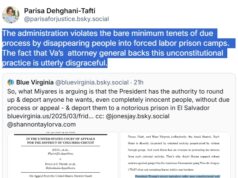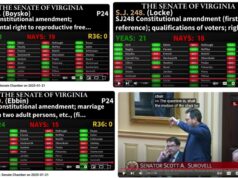tl;dr: A bill last year (Dick Saslaw, Patrick Hope, Dave Marsden, Barbara Favola) mandated an annual Dept. of Corrections report on the use of solitary confinement. I would grade it a D+ on meeting the rubric. It’s nearly impossible to tell how many people are spending months or even years confined to a small cell for 22 hours per day.
************
Legislation written during the 2018 General Assembly session required the Virginia Department of Corrections (VADOC) to begin regularly reporting statistics on the number of people in “restricted housing” (euphemism for solitary confinement) in their institutions. A little insight into how the legislative process plays out: following a shocking 2018 ACLU report on the conditions of solitary confinement in Virginia (despite a number of changes VADOC had introduced since 2011), a number of legislators—Senators Marsden, Favola and Saslaw, and Delegate Hope—decided to tackle this issue, working in concert with the ACLU and other organizations.
They each had a variety of potential legislative goals, including ending the use of solitary confinement for juveniles altogether (which Delegate Hope had attempted to pass in 2018), restricting solitary use to non-punitive purposes, restricting the allowed length of confinement, setting stricter standards for the use and conditions of solitary confinement, and, the mildest approach–collecting data on the use and conditions of solitary to inform future legislative efforts. Many other states have a variety of regulations and restrictions on the use of solitary confinement, but Virginia has very few.
Early discussions with the agency heads, and with Secretary of Public Safety Brian Moran made it clear that the only approach that would be supported by the Administration was this data collection. Even there, the final bill—from how solitary was defined, all the way to what criteria VADOC would be required to report—was weakened considerably from early drafts. The ACLU opposed the bill, because the definition of solitary being used in the bill (“special-purpose bed assignments operated under maximum security regulations and procedures, and utilized under proper administrative process, for the personal protection or custodial management of offenders”) diverged from the generally-accepted definition: “a placement that requires an inmate to be confined to a cell an average of 22 hours or more per day.” Note that the version in the bill is wholly vague—what is a “special purpose bed assignment?” Would a count of these assignments equal a count of people confined to a cell 22 hours a day? Who knows?
Additionally, the ACLU opposed the bill because it only required reporting of statistics aggregated over all institutions, which would allow the VADOC to hide from the public any particular facility that was using solitary in an egregious way.
In October, the report was released. It’s 151 pages long, but here is a list of the required reporting criteria in the new law, and a description of whether or how the VADOC reported those details. “The Department shall report to the General Assembly and the Governor on or before October 1 of each year the following information for the Department, in the aggregate for the previous fiscal year:”
1. The average daily population. The report states that the average daily population is 29,994.
2. The number of offenders who were placed in and the number of offenders who were released from restrictive housing. Here the VADOC reports those entering during the fiscal year (7,121), and those exiting during the fiscal year (7,331). Note though that this does not indicate the number in restrictive housing, because anyone housed there at the start of the fiscal year is not observed entering—and might, in fact, still be housed there at the end of the fiscal year, and thus be excluded from entry and exit statistics. (Especially likely in the higher security Red Onion and Wallens Ridge prisons, where length of stay in restrictive housing often exceeds a year.)
3. The age, sex, race, ethnicity, mental health code, medical class code, security level, and custody level classification of each offender housed in restrictive housing or a SAM Unit. The VADOC doesn’t even come close to properly reporting this, instead reporting the average of these statistics for the 521 who happen to be in restrictive housing on one random day—the end of the fiscal year, June 30, 2019. What is more relevant than the makeup of those who happened to be in solitary that day is the makeup of the 7,121 unique individuals who entered into solitary at any time throughout the year (plus those who were in solitary before the year began)—or, even better, the makeup of every incident of restrictive housing placement, counting some individuals multiple times for each time they cycle into restrictive housing. This number exceeds 11,000, based on the number of releases reported. The short-term restrictive housing population is 58% black, with an average age of 35.2 years, and 51% have no history of mental illness. Restrictive housing at Red Onion and Wallens Ridge is 81% black, with an average age of 37.9, and 35% have no history of mental illness.
Note too that SAM Units, or Shared Allied Management Units (euphemism much?) are defined as “general population environment used to promote safety within institutions by avoiding the use of restrictive housing to manage vulnerable populations that typically require a high level of services from security, mental health, or medical staff,” which sounds much like a “special-purpose bed assignment” but that VADOC claims are not restrictive housing. It’s possible these would fall under the generally accepted definition of solitary, even if not falling under the VADOC’s peculiar definition. The population in the SAM Units is only 41% black, the average age is 44.5, and only 16% have no history of mental illness.
4. The disciplinary offense history preceding placement in restrictive housing or a SAM Unit. I’m not sure what we were expecting to get here, but the report only incudes a mean and median number of “Disciplinary Offense Convictions” (during the person’s entire time incarcerated) prior to entering restrictive housing (around 2 serious and 7 lesser offenses for those in short-term solitary, and 9 serious and 18 lesser offenses for those in Red Onion and Wallens Ridge).
Delegate Hope’s version of this bill would have required the report to include “the basis or bases for placement in solitary confinement for each inmate” to help determine why people are placed into restrictive housing, as well as information on self-harm during solitary, and times sick during solitary.
5. The number of days each offender spent in restrictive housing. Here too the VADOC doesn’t come close to reporting this number. Instead of the number of days each person spent, the report only contains information about the length of completed incidents of solitary confinement. First, the percent of short-term restrictive housing incidents lasting <5 days (26%), 5-9 days (16%), 10-14 days (10%), 15-29 days (19%) and more than 30 days (29%); the percent of Red Onion and Wallens Ridge restrictive housing incidents lasting <3 months (6%), 3-6 months (26%), 6-12 months (48%), 12-18 months (10%), and 18 months or more (9%). Note that this only counts those released from solitary, which biases the number downward. Additionally, there’s no way of knowing how much more than 30 days people are in short-term solitary. There might be people in solitary for years, and it would still be reported like this. The reported median length of 14.1 days doesn’t really illuminate things any further.
6. The number of offenders released from restrictive housing directly into the community. According to the report, 162 people were released directly from solitary to the community. VADOC claims this can happen when someone requests solitary confinement in the month leading up to their release from prison, in order to prevent any altercations that might prevent their release.
7. The number of full-time mental health staff. There were 161 full-time mental health staff at the end of the fiscal year.
8. Any changes made during the reporting period to written policies or procedures of the Department and each state correctional facility relating to the use and conditions of restrictive housing and SAM Units. The report includes an appendix of all written policies, as well as changes and amendments made to the policies.
The data from this report reveal far less information than those who care about civil rights would like. It’s not clear how many individuals are in solitary for very long periods of time—and as the ACLU testified in the committee meeting, physical and mental deterioration set in in as little as ten days of solitary confinement. It’s not clear why people are being placed in solitary. It’s not even clear how many individuals are in what the ACLU would consider solitary. Other states manage to collect more relevant and useful data on the use of solitary, certainly Virginia can too.



 Sign up for the Blue Virginia weekly newsletter
Sign up for the Blue Virginia weekly newsletter
![Video: Mother of Timothy McCree Johnson Says “Gov. Youngkin’s Actions [in Pardoning Police Officer Who Shot Her Son] Are Egregious, Malicious and Prejudiced”; Adds, “if this is the legacy that Gov. Youngkin wants to leave behind, then so be it – that’s also between him and his god.”](https://bluevirginia.us/wp-content/uploads/2025/03/shifflettmother-238x178.jpg)







